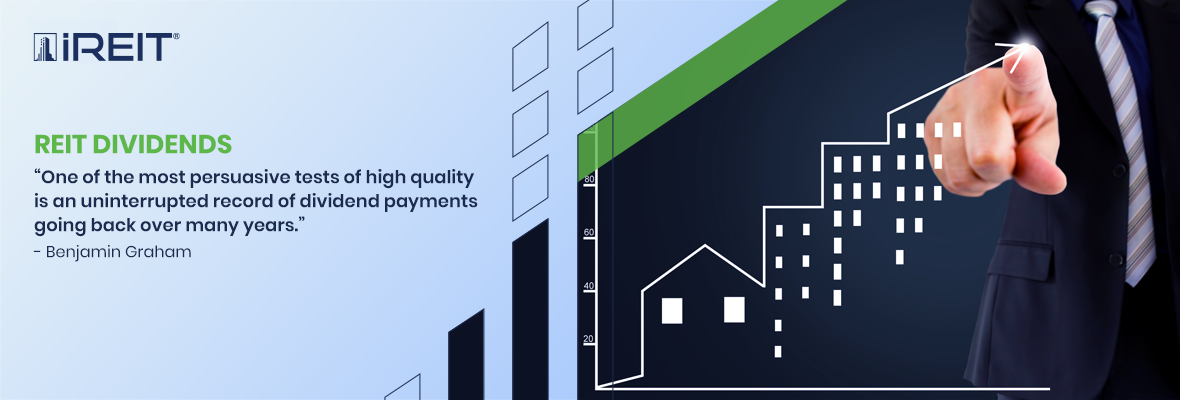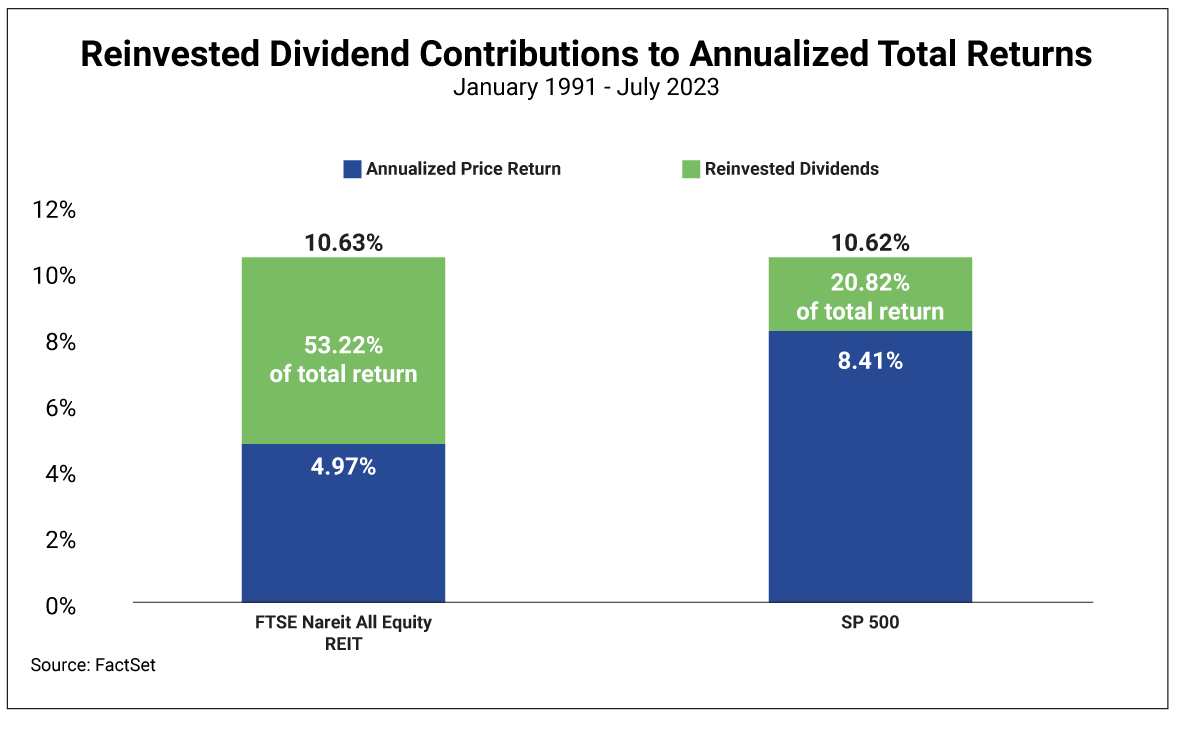
Real estate investment trusts are known for their dividends thanks to the REIT structure itself.
By law, these entities must pay out at least 90% of their taxable income to shareholders.
Why is this so important? Let’s look at it first from a more market-wide view. As S&P Global published on September 2021:
“Dividends play an important role in generating equity total return. Since 1926, dividends have contributed approximately 32% of total return for the S&P 500, while capital appreciations have contributed 67%. Therefore, sustainable dividend income and capital appreciation potential are important factors for total return expectations.”
REIT dividends, meanwhile, can be even more effective. Consider the chart below, where the percentage impact of annualized price returns is recorded in dark blue and reinvested dividends in light blue for both REITs and the S&P 500.

As global REIT advocate Nareit notes:
“The chart above displays the annualized price and total returns for REITs (FTSE Nareit All Equity REIT Index) and the broader equity market (S&P 500 Index) from January 1991 to July 2023, typically referred to as the modern REIT era. It also shows the contribution of reinvested dividends to annualized total returns (as a percentage of total returns) for each index.”
Over this time period:
“… public equity real estate total returns have been, on average, comparable to those of the broader equity market. From January 1991 to July 2023, annualized total returns for the FTSE Nareit All Equity REIT Index and S&P 500 Index were 10.63% and 10.62%, respectively. While overall investment performance has been similar for both indices, the contributions of reinvested dividends and price returns to overall performance have been starkly different. Reinvested dividends accounted for more than half (53.22%) of REIT total returns; they comprised approximately one-fifth (20.82%) of equity total returns. Dividends play an important role in REIT total returns.”
One quick note about that overall investment performance is warranted here. U.S. REIT stock prices underperformed the S&P 500 intensely in 2022 well into 2023. We expect this discrepancy to change going forward, which will skew the numbers listed above even more favorably for REITs.
This could, of course, take time. But here’s the best part: REIT investors are paid to sit tight and wait for bigger, better things.
REITs only came into existence in 1960, so they haven’t been on the market as long as many other investing options. Yet they still have a well-established history of consistently raising their dividends.
The global financial crisis in 2008 and then the global shutdowns of 2020 did take too many REITs by surprise. Though, in their defense, 2020 took just about everyone by surprise. (2008 probably shouldn’t have. The warning signs were all there.) But regardless of who was at fault and who wasn’t, the results were the same: a slew of REITs cutting their dividend payouts to the minimum required level in order to preserve capital.
As conditions – and cash flow – have improved across nearly all property sectors since the shutdowns, dividends have made a strong comeback. And U.S. REITs should continue to see healthy dividend growth going forward.
It’s also only fair to mention that a number of REITs managed the shutdowns not only without cutting their dividends… but even continuing to raise them. This was especially true of the net-lease sector, as described on our REIT Sectors page.
Understanding REIT Dividend Growth
A REIT’s cash flow growth can come organically from rising rents and occupancies, or externally from development and acquisitions. Regardless, as a REIT’s income increases, it must ensure that its distribution rate remains at or above the level required by law.
This often means it must raise its dividend – something that suits investors just fine.
There’s another benefit worth mentioning. It’s something the late REIT legend, Ralph Block, explains in his excellent book, Investing in REITs:
“There’s an intangible psychological benefit in seeing significant dividends roll in each month or each quarter. If, like most of us, you have to earn a salary, seeing a check come in for several hundred dollars – without you having to show up at the office – provides substantial comfort regardless of whether you intend to spend it or reinvest it.”
If you’re not retired, my advice is almost always going to be to reinvest it, for the record. By putting that money back into the stock that gave it to you, you’ll be increasing your dividend potential.
More shares owned means more dividends paid into your pocket… which means even more shares you can own… which means even more dividends paid into your pocket… which means even more shares you can own… which means even more dividends paid into your pocket.
If you continue that cycle for a decade or two, you could find yourself with quite the sizable payouts to live off of once you do retire.
But even if you’re spending that money right away every time, the psychological benefit of receiving consistent dividend payments should not be overlooked. A content, confident investor is an investor who’s less likely to make emotion-based decisions and therefore the kind of classic market mistakes that lose so much wealth for ordinary investors every year.
Not All Dividends Are the Same
One key metric that REIT investors should always consider is the payout ratio of dividends to adjusted funds from operations, or AFFO (as discussed on the REIT Valuation page). A modest payout ratio is actually a good thing – it both supports investors and allows the company to sustain itself and even grow in the future.
Exactly what that ratio should be depends on the sector and even the specific company. For instance, in the iREIT® Ratings Tracker, the healthcare, net lease, and mall sectors have average current P/AFFO’s of 13.30, 12.11, and 11.05, respectively. However, the cannabis sector has a current P/AFFO of 7.30 while the lodging sector has a current P/AFFO of 9.42.
Regardless, keeping a decent amount of cash on hand allows a REIT to be ready to pounce on profitable buying opportunities that come around. It also acts as insurance against unexpected events that might cause temporary downturns in free cash flow.
No matter how traditionally safe REITs can be, it’s important to remember that they operate in cyclical industries. They have their ups and downs, their booms and busts. This is true of individual areas and sectors at a time, as well as on an all-encompassing scale. So real estate investors – both on the company level and the shareholder level – need to be prepared for such negative turns.
They also need to expect unforeseen lawsuits, tenant bankruptcies, and other undesirable impactful possibilities. In short, things happen. You can – and should – work hard to hold only the strongest assets under the most ideal circumstances. But understand that there is only so much you can control.
Watch Out for Sucker Yields
Again, there’s only so much you can control. But, allow us to reiterate the point that you can – and should – work hard to hold only the strongest assets under the most ideal circumstances. That includes keeping a sharp eye out for warning signs.
There’s no need to get spooked by every negative data point that comes along. You do, however, need to be aware of those data points and whether they’re isolated or part of a trend.
There are usually warning signs when it’s the latter. For example, if you don’t want to face an unexpected dividend cut, know the signs.
When a REIT pays out too much…It’s a doubly whammy: a recipe for disaster that we call a sucker yield
How do you spot a sucker yield? Oftentimes, just a quick glance at a company’s summary on your given financial platform can indicate as much. REIT yields tend to be higher than other dividend stocks, but that doesn’t mean they’re supposed to be sky-high. So if your REIT of choice is offering an 8% yield, 9% yield, 10% or higher…
There’s a very good chance the company is in trouble.
Don’t read “very good chance” as “absolute certainty.” There are examples of healthy REITs with 8%-10% dividend yields at times. Still, if you see those numbers, your first reaction should be to dig deeper and understand why that figure is what it is.
Think of it this way: When a company pays a dividend beyond its earning power, it’s eroding capital. Which means it’s either a) fallen on tough times, b) not being very well managed, or c) both. And if it’s either of the latter two – and maybe even the former – then there’s a good chance that it’s cut its payouts before… and that its balance sheet features considerable leverage.
Let’s say that “GHI REIT” earned $1.20 per share in AFFO last quarter but uses $0.20 for total capital expenses. That leaves it with no more than $1.00 for dividend payments.
And if it pays out that whole $1.00, then it has nothing left – no margin of safety – to expand the business or prepare for unforeseen expenses and opportunities.
As we’ve already established, that’s a problem. A major one.
Even so, we know the lure of a sucker yield is strong… Big financial numbers tend to make us get big, fat dollar signs in our eyes that obscure our perception of reality.
Give reality a chance anyway. Fight to look past the yield to the actual dividend behind it, including its sustainability. It’s just not worth it to obtain dividend quantity over dividend quality.
Trust us when we say you don’t want any part of them.
The Monthly Paying REIT
There are a few publicly traded REITs in the U.S. that pay out monthly dividends. But most of them stick with the quarterly kind.
Most non-traded U.S. REITs pay monthly. So do the majority of Canadian REITs. In the latter case, that’s because most of their investors are of the retail (i.e., mom and pop) variety. Institutional portfolio managers – pension funds, school endowments, private equity firms, and the like – in the U.S.’ northerly neighbor prefer to deal directly with private real estate.
As mentioned in Brad’s latest book, REITs for Dummies, that’s not as much of an issue in the U.S. While American-based institutional investors can be very heavily involved in private real estate purchases, they tend to hold significant REIT positions as well. So it’s not an exact apples-to-apples comparison in that regard.
All the same, we would like to see more of its members convert to monthly models. This switch would require very little effort on their part while offering investors automatic and obvious benefits.
What About the Tax Man?
Just because a REIT pays out at least 90% of taxable income in the form of dividends doesn’t mean that Uncle Sam misses out. He always gets his bite of the apple, make no mistake.
In this case, it’s mainly by way of investors.
Don’t panic at this information, but the dividend payments you receive as a REIT investor can be taxed as ordinary income, capital gains, or return on capital. That sounds confusing, we know, but you’re not left alone in figuring it out.
Every year, every REIT must send a 1099-DIV breakdown of what is what. And most of the time, that tax document is going to tell you that your dividend income qualifies as ordinary income.
There’s other important information you’ll need to know in the 1099-DIV, including whether to claim some of that income as a loss – or as nontaxable all around. So be careful to read over the entire thing carefully and/or involve a tax professional when filing your yearly IRS obligations.
Finally, for anyone investing in U.S. REITs outside of the country – or those investing internationally in general – be aware that you might have additional government fees to worry about. There’s always a give and take to pushing the borders, and this area is definitely one of the less appealing aspects to consider.

